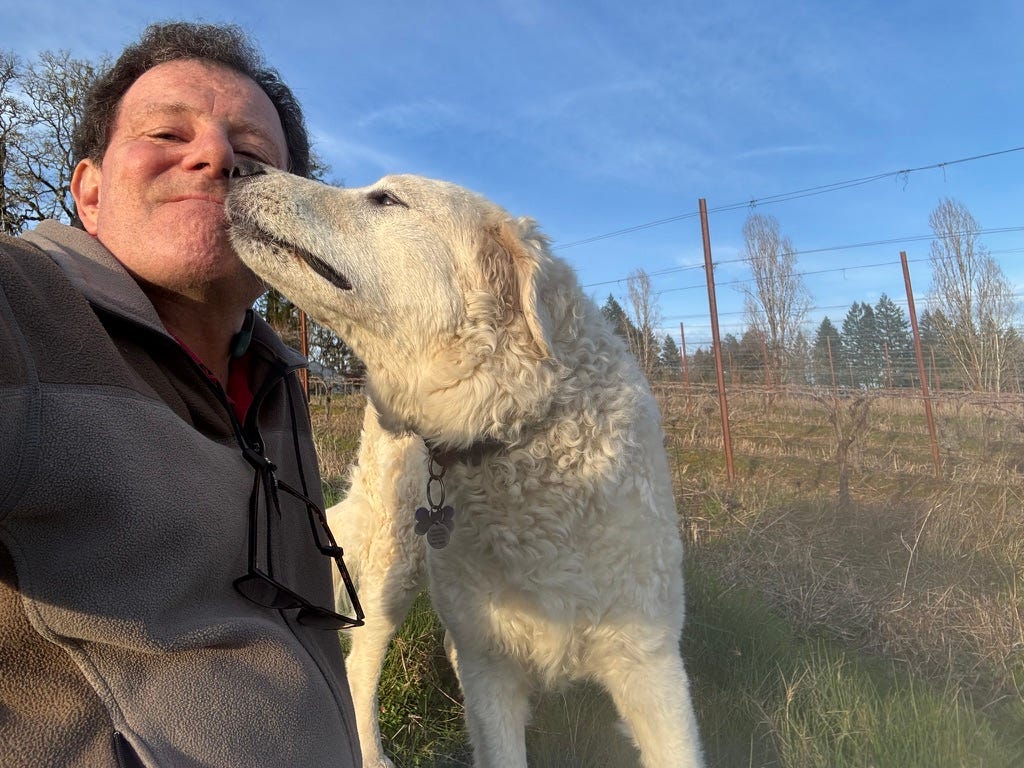Pinot noir is "Sex in a Bottle"
With apologies to Shakespeare, Nature might stand up and say to all the world, 'This is a grape!'"
These newsletters have often aimed for humor or for highlighting farm life or wildlife. But today we want to explain why it is we’re growing mostly Pinot Noir grapes, as opposed to cabbages or hazelnuts (like so many other Willamette Valley farmers). And in fairness we also have timber on our property, and we grow cider apples that we’re proud of, and Chardonnay grapes as well. But today’s topic is what we think of as the most amazing grape: the Pinot Noir.
At one level it doesn’t make a lot of sense to grow Pinot Noir vines. They’re notoriously finicky and require more hand care and TLC than other grapes, and yields are lower. There’s a saying, “God made cabernet sauvignon, but the devil made pinot noir.” Any grower will nod at that.
In his book “The Grail,” about an Oregon vineyard’s quest to make the best Pinot Noir in the world, the late Brian Doyle quotes a Pinot grower:
He sails on a monologue that begins by lauding the complexity and subtlety of the wine that comes from the grape, but then swerves into how the grapes are as thin-skinned as teenagers in a new school, and how the vines are all prissy about how they need just the right amount of sunlight and water, not too much, and not too little, and how they totally quail and fail under rain that falls too hard, and they swoon at the slightest stress, and you have to darn well nearly feed them with a spoon when they’re babies, and you might as well go around the vineyard at night and swaddle each vine in a blanket for heavensake, and rock them gently to sleep.
Yup. All true. But after all the headaches, what you get in the end as a reward is Pinot Noir. And it’s poetry in a bottle. Nothing quite like it.
Pinot Noir grapes are among the oldest varieties, and there is some evidence that they were cultivated in Roman times in France. The word “pinot” means pine, because the grape’s clusters can look like a pine cone. In the middle ages, monks meticulously cultivated vineyards, recognizing that Pinot Noir thrived in Burgundy’s cool climate and soils rich in limestone. The monks developed a rich vocabulary of terroir—how climate, slope and soil affect the taste of wine. One Benedictine monk became a master at blending wines and created the first still red wine using corks and bottles which didn’t explode as often during fermentation. His name was Dom Pérignon.
While the best Pinot Noir traditionally was from Burgundy, California also produces top-notch Pinot Noir. But even though the first vintage of Oregon Pinot Noir was only in 1967, it was soon recognized as sensational. In 1985, experts at the International Wine Center held a “Burgundy Challenge” with blind tastings of top French and Oregon Pinot Noirs — and the first five places went to Oregon wines. That was a turning point.
What’s special about Pinot Noir? First, before you even take a sip, that aroma! The floral nose sweeps you away (and if you have have the right glass, you may even float). Pinot also has a voluptuous complexity to it, offering a dark, swirling mystery that is often compared to falling in love. And you know where love leads: One sommelier has described Pinot Noir as “sex in a glass.”
More than other varieties, Pinot Noir also reflects the terroir of the vineyard, meaning that there are subtle taste differences from one vineyard to another, even one block of a vineyard to another. Pinot Noir has lower tannins than some other red wines and is known for red or dark fruit flavors and sometimes spice, earthiness and minerality. It also ages beautifully, becoming more complex over time.
The attraction of a good Pinot may be a bit hard to describe, but look at the words we’ve used: love, sex, voluptuous. That’s the thing about sipping Pinot Noir: There’s a sensuousness to it that has, er, seduced us, hence we grow its grapes in our vineyard.
*************************************************************
Sheryl and Nick attended the Pacific Northwest Cider Association symposium in Tacoma recently, with discussions about everything from cider-making to managing cider clubs. Here they are at the trade show:
Meanwhile, Chief Security Officer took a break from her role keeping gophers in check by welcoming Nick back from a difficult overseas trip:
We will again open up Kristof Farms to periodic tastings (and wine club and cider club members can pick up their packages here; stay tuned). But remember that our wines are always available here in wine country at the Winemakers Studio in neighboring Carlton, open 11-5 every day. Ask Nick George, who works the bar, for guidance; he knows his wines! Which is also to say, our wines!
There are hints here on the farm that spring is sprung, so we send all of you our warmest congratulations on making it through the winter. Let’s raise a glass — perhaps of Pinot Noir, “sex in a glass” — to spring!








What a blessing it must be, Mr Kristoff, to return to your family and farm from the challenging work you do - out there in the unreal world. Thank you for that!
I'm looking forward to a glass of Kristoff Farms Pinot Noir soon.
My wife and I have enjoyed Mr. Kristoff's columns in the New York Times for many years! We always thoroughly enjoy every one of his columns and look forward to every one!!!
We are most appreciative of Mr. Kristoff's superb writing!!!!!!!!!!!!!!!!!!!!!!